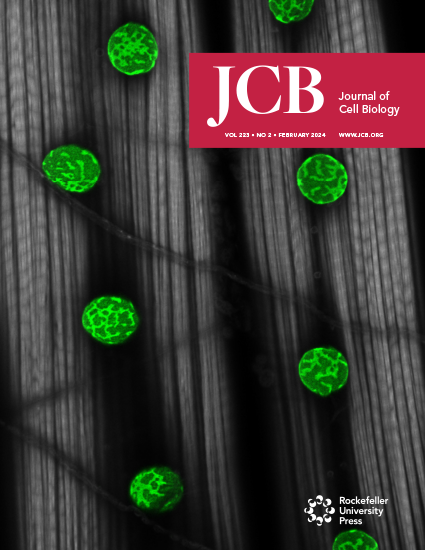KIF2A stabilizes intercellular bridge microtubules to maintain mouse embryonic stem cell cytokinesis.
IF 7.4
1区 生物学
Q1 CELL BIOLOGY
引用次数: 0
Abstract
Cytokinesis, the final stage of cell division, serves to physically separate daughter cells. In cultured naïve mouse embryonic stem cells, cytokinesis lasts unusually long. Here, we describe a novel function for the kinesin-13 member KIF2A in this process. In genome-engineered mouse embryonic stem cells, we find that KIF2A localizes to spindle poles during metaphase and regulates spindle length in a manner consistent with its known role as a microtubule minus-end depolymerase. In contrast, during cytokinesis we observe tight binding of KIF2A to intercellular bridge microtubules. At this stage, KIF2A maintains microtubule length and number and controls microtubule acetylation. We propose that the conversion of KIF2A from a depolymerase to a stabilizer is driven by both the inhibition of its ATPase activity, which increases lattice affinity, and a preference for compacted lattices. In turn, KIF2A might maintain the compacted microtubule state at the intercellular bridge, thereby dampening acetylation. As KIF2A depletion causes pluripotency problems and affects mRNA homeostasis, our results furthermore indicate that KIF2A-mediated microtubule stabilization prolongs cytokinesis to maintain pluripotency.KIF2A稳定细胞间桥微管以维持小鼠胚胎干细胞的细胞分裂。
细胞质分裂是细胞分裂的最后阶段,用于物理分离子细胞。在培养的naïve小鼠胚胎干细胞中,细胞分裂持续时间异常长。在这里,我们描述了激酶13成员KIF2A在这一过程中的新功能。在基因组工程小鼠胚胎干细胞中,我们发现KIF2A在中期定位于纺锤体极点,并以与其已知的微管负端解聚合酶的作用一致的方式调节纺锤体长度。相反,在细胞分裂过程中,我们观察到KIF2A与细胞间桥微管紧密结合。在这个阶段,KIF2A维持微管的长度和数量,并控制微管乙酰化。我们提出,KIF2A从解聚合酶转化为稳定剂是由抑制其atp酶活性驱动的,这增加了晶格亲和力,并倾向于紧凑的晶格。反过来,KIF2A可能在细胞间桥上维持紧致的微管状态,从而抑制乙酰化。由于KIF2A缺失导致多能性问题并影响mRNA稳态,我们的研究结果进一步表明,KIF2A介导的微管稳定延长了细胞分裂以维持多能性。
本文章由计算机程序翻译,如有差异,请以英文原文为准。
求助全文
约1分钟内获得全文
求助全文
来源期刊

Journal of Cell Biology
生物-细胞生物学
CiteScore
12.60
自引率
2.60%
发文量
213
审稿时长
1 months
期刊介绍:
The Journal of Cell Biology (JCB) is a comprehensive journal dedicated to publishing original discoveries across all realms of cell biology. We invite papers presenting novel cellular or molecular advancements in various domains of basic cell biology, along with applied cell biology research in diverse systems such as immunology, neurobiology, metabolism, virology, developmental biology, and plant biology. We enthusiastically welcome submissions showcasing significant findings of interest to cell biologists, irrespective of the experimental approach.
 求助内容:
求助内容: 应助结果提醒方式:
应助结果提醒方式:


